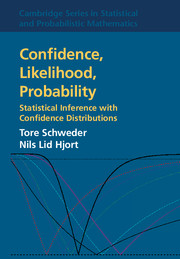Book contents
- Frontmatter
- Dedication
- Contents
- Preface
- 1 Confidence, likelihood, probability: An invitation
- 2 Inference in parametric models
- 3 Confidence distributions
- 4 Further developments for confidence distribution
- 5 Invariance, sufficiency and optimality for confidence distributions
- 6 The fiducial argument
- 7 Improved approximations for confidence distributions
- 8 Exponential families and generalised linear models
- 9 Confidence distributions in higher dimensions
- 10 Likelihoods and confidence likelihoods
- 11 Confidence in non- and semiparametric models
- 12 Predictions and confidence
- 13 Meta-analysis and combination of information
- 14 Applications
- 15 Finale: Summary, and a look into the future
- Overview of examples and data
- Appendix: Large-sample theory with applications
- References
- Name index
- Subject index
Overview of examples and data
Published online by Cambridge University Press: 05 March 2016
- Frontmatter
- Dedication
- Contents
- Preface
- 1 Confidence, likelihood, probability: An invitation
- 2 Inference in parametric models
- 3 Confidence distributions
- 4 Further developments for confidence distribution
- 5 Invariance, sufficiency and optimality for confidence distributions
- 6 The fiducial argument
- 7 Improved approximations for confidence distributions
- 8 Exponential families and generalised linear models
- 9 Confidence distributions in higher dimensions
- 10 Likelihoods and confidence likelihoods
- 11 Confidence in non- and semiparametric models
- 12 Predictions and confidence
- 13 Meta-analysis and combination of information
- 14 Applications
- 15 Finale: Summary, and a look into the future
- Overview of examples and data
- Appendix: Large-sample theory with applications
- References
- Name index
- Subject index
Summary
A generous number of real datasets are used in this book to illustrate aspects of the methodology being developed. Here we provide brief descriptions of each of these real data examples, along with key points to indicate which substantive questions they relate to. Some of these datasets are small, partly meant for simpler demonstrations of certain methods, whereas other are bigger, allowing also more ambitious modelling for reaching inference conclusions. Key words are included to indicate the data sources, the types of model we apply and for what inferential goal, along with pointers to where in our book the datasets are analysed.
Lifelength in Roman era Egypt
In Spiegelberg (1901) the age at death has been recorded for 141 Egyptian mummies, 82 male and 59 female, dating from the Roman period of ancient Egypt from around year 100 B.C. These lifelengths vary from 1 to 96 years, and Pearson (1902) argued that these can be considered a random sample from one of the better-living classes in that society, at a time when a fairly stable and civil government was in existence. These data are analysed by Claeskens and Hjort (2008, pp. 33–35), in which nine different parametric models for hazard rates are compared and where the Gompertz type models are found to be best.
In Example 1.4 we fit a simple exponential model to the lifelengths of the male to motivate the concepts of deviance functions and confidence curves. In Example 3.7 we find the confidence distribution for the ratio of hazard rates for female to that for the men (in spite of Karl Pearson's comment, “in dealing with [these data] I have not ventured to separate the men and women mortality, the numbers are far too insignificant”). A certain gamma process threshold crossing model is used in Exercise 4.13, providing according to the Akaike information criterion (AIC) model selection method a better fit than the Gompertz. For Example 9.7 we compute and display confidence bands for the survival curves, for the age interval 15 to 40 years. Then in Example 10.1 the data are used to illustrate the transformation from confidence distribution to confidence likelihood, for the simple exponential model, following Example 1.4, whereas Example 11.1 gives the confidence density for the cumulative probability F(y0), that is, the probability of having died before y0, again comparing male with female.
- Type
- Chapter
- Information
- Confidence, Likelihood, ProbabilityStatistical Inference with Confidence Distributions, pp. 437 - 446Publisher: Cambridge University PressPrint publication year: 2016



